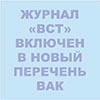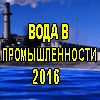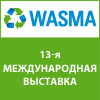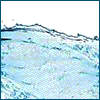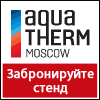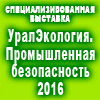|
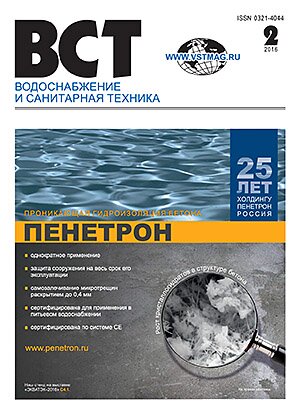
Number 2 / 2016
To download all number in format PDF (in Russian)The further text is accessible on a paid subscription.
For authorisation enter the login/password.
Or subscribe
Number maintenance (pdf) (doc)
Number abstract (doc)
Literature lists to articles (doc)
|
bbk 000000
Dovlatova E. V.
The activity of RAWW is a consistent upholding of the interests of the water industry enterprises
|
| Read more... |
bbk 000000
УДК
Samburskii G. A.
Problems of water quality safety, water sources deterioration, development of reserve sources and establishing protective sanitary zones. Ways of observing the requirements of Sanitary Rules and Regulations (review of the round-table discussion)
|
| Read more... |
bbk 000000
UDC 628.112.2
ALEKSEEV V. S., Martintsov S. M.
On the evaluation of the life cycle of the wells operating at the existing water intakes
Summary
Life cycle or useful life expectancy of fixed assets including water abstraction wells is regulated by RF Government Decree No. 1 of 2002. For water abstraction wells the life cycle is 15–20 years. Besides, the requirements to the life cycle in the environmental management system are formulated in the system of RF state standards authentical to ISO 14000. On the basis of the experience of operating underground water intake facilities is shown that reaching the design operating life is possible only on the condition of complying with the requirements to the selection of well filters and gravel packages for water abstraction mode that minimize the hydraulic losses in the near-filter zones. The guidelines for meeting these requirements have been formulated. At the stage of hydrogeological survey of the underground water resources assessment is suggested to make predictions of the water corrosiveness and the ability to release clogging compounds and biological colmatage.
Key words
water well , hydraulic losses , life cycle , colmatage , near filter zone , useful life expectancy , environmental management
|
| Read more... |
bbk 000000
UDC 628.35:661.635
Ambrosova G. T., Funk A. A., Ivanova Sargylana Dmitrievna, Ganzorig Shonkhor
Comparative evaluation of the methods of phosphorus removal from wastewater
Summary
The evaluation of the methods of eliminating phosphorus, a most important nutrient that is a limiting element in water body eutrophication, from wastewater is presented. Biological, physical, chemical and combined methods are considered that differ from each other in the method of implementation, construction and operating expenditures. The biological method is based on phosphorus removal through its utilization in biomass synthesis in the biological system. Physical and chemical methods suppose mandatory application of chemicals used for free phosphate-ion binding to low soluble ortho-phosphate. Combined methods suppose dephosphorization at the biological treatment stage with subsequent inclusion of phosphate-ions into crystals at the physical and chemical treatment stage. The examples of practical implementation of the methods are presented; process flow schemes are considered; the process parameters of the treatment facilities are pointed out where the process of phosphorus removal is taking place; the data on the process efficiency is provided; the advantages and drawbacks of the applied methods are reported. The experience of adjustment works is described together with the results of experimental selection of chemicals for phosphorus binding and determination of the optimal point of their addition carried out by the authors in the laboratory, during pilot and full-scale studies.
Key words
aeration tank , nutrient , bioreactor , denitrification , dephosphorization , effluent polishing , crystal , nitrification , sludge growth , reagent
|
| Read more... |
bbk 000000
UDC 628.218
Doskina E. P., Moskvicheva A. V., Moskvicheva E. V.
On the application of permissible pollution limit values for effluents discharged into the wastewater disposal system of Volgograd
Summary
The RF legislation in force regulates the permissible concentrations of pollutants discharged to the sewers and municipal and communal treatment facilities. For many communities compliance with the calculated values of the permissible concentrations turned to be technically unachievable. The standards in force in Volgograd for effluent pollution concentrations discharged by the users into the municipal sewer were calculated for all the users except the residential sector. This resulted in establishing unreasonably stringent limits to certain pollutants. In order to comply with these requirements every industrial user would have to build separate local treatment facilities which in its turn eliminate the need in the municipal treatment facilities. The analysis of the limit values of pollutants discharged into the Volgograd wastewater disposal system from 1997 to 2011 was carried out. The limit values adopted in 2011 and in force at present have been too low compared to the actual quality of domestic sewage; this can produce a disturbing effect on the performance of the biological treatment facilities and result in the pollution of the water bodies. The system of regulating the quality of effluents discharged by the users is considered. The causes of unreasonably stringent permissible pollution concentrations set by calculations; and the duality of the requirements set to the effluent quality are presented. The conclusion of the necessary revision of the regulated limit values with account of the legislation in force and operation of the treatment facilities in accordance with the regulations is made.
Key words
pollutants , regulation of permissible discharge , treatment facilities , water disposal system , wastewater
|
| Read more... |
bbk 000000
UDC 628.316.12
Yavtoushenko M. V., Larionov S. Iu., Panteleev A. A., Riabchikov B. E., Shilov M. M., Kasatochkin A. S., Zhadan A. V.
Testing IKO-R enhanced coagulation pilot plant
Summary
An experimental plant with a capacity up to 20 m3/h was developed for enhanced coagulation of surface and waste water as well as storm water. The treatment process is based on sedimentation of inclusions together with coagulated flocs under the optimal conditions of chemical addition and mixing. To enhance the sedimentation process sludge recycling from the settling tank was provided that ensured the formation of big flocs. Pilot tests of the plant were carried out to evaluate the efficiency of removing suspended solids and phosphorus from the effluent during tertiary treatment at the Podolsk wastewater treatment facilities in the Moscow Area. The capacity of the plant during testing varied from 3 to 15 m3/h. At steady operation of the settling tank no sludge washout was observed. During longer tests the capacity was 8–10 m3/h; in terms of the cross section of the settling tank the specific capacity (flow rate) was 5–7 m3/(m2·h). Time to reach the steady state conditions was 5–10 minutes. At that the efficiency of phosphorus removal was 80%, permanganate value was reduced by 54% and suspended solids concentration was reduced by 58%.
Key words
enhanced treatment , coagulant , coagulation , pilot plant , sludge recirculation , flocculant
|
| Read more... |
bbk 000000
UDC 628.35:66.081.63
Murashev S. V., Solov'eva E. V., Shilova N. K.
The experience of wastewater treatment technology approbation on the basis of a membrane bioreactor
Summary
The results of testing two low-capacity pilot plants for wastewater treatment with the use of different process flow schemes: with a membrane bioreactor (MBR) and a secondary settling tank are presented. MBR technology provides for combining micro- and ultrafiltration with aerobic biological treatment of wastewater. On the basis of the obtained experimental data it is shown that the plant with the membrane bioreactor provides for higher treatment performances, chemical-free advanced phosphorus removal, sustained quality of discharged effluent and high efficiency of removing substances resistant to oxidation. The main drawback of the MBR technology is the need for regeneration of membranes with high efficiency that additionally complicates the process control. The data on the membrane throughput capacity varying depending on the bioreactor running time and efficiency of chemical regeneration of membranes is presented.
Key words
chemical-free treatment , water disposal , local treatment facilities , membrane bioreactor , wastewater
|
| Read more... |
bbk 000000
UDC 628.24
Voronin S. G., Skrebnev Iu. V.
Improving the environmental safety of sewage pipeline laying with the use of new breed ceramic pipes
Summary
The characteristics and advantages of the advanced sewage ceramic pipes of new breed are presented as well as the range of products and the technology of pipe manufacture with the use of clay and chamotte. Taking into consideration the distinctive advantages of ceramic pipes (long lifetime of pipes and fittings; tightness of abutted joints; high chemical resistance; non-wearing of the inner surface of pipes, fittings and abutted joints), the conclusion of the expediency of launching large-scale ceramic pipe manufacture in Russia is made. Alongside with the introduction of ceramic pipes developing the standards with account of the entire lifetime of all the sewage pipelines and advanced technical equipment for open and trenchless pipe laying is required.
Key words
ceramic sewage pipes , open and trenchless pipe laying , fittings , ecological safety
|
| Read more... |
bbk 000000
UDC 628.147.2
Karmazinov F. V., PANKOVA G. A., Ipatko M. N., IGNATCHIK V. S., Ignatchik S. Iu., Sarkisov S. V., Putilin P. A.
Methods of optimization of the zoned water supply system
Summary
The method of optimization of water supply systems with account of the expenditures for eliminating failures in the water distribution networks depending on the pipe material, diameter and network operating pressure is presented. Computational simulation of the hydraulic operational modes of the water supply system (with the use of the mathematical model) with determining the optimal operating pressure in the dictating point of the network was carried out. The developed method of the water supply system optimization provides for determining the operating expenditures at different pressure values in the distribution networks; determining the cost effective operational mode with account of the investment and operation and maintenance costs; optimizing the electric energy costs with account of the cost of eliminating failures in the water distribution networks that depend also on the design pressure value.
Key words
pressure in the water supply systems , operation and maintenance costs , rate of failure , optimization , water supply system , net discounted expense
|
| Read more... |
|

